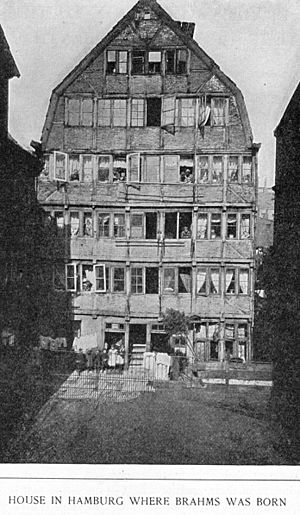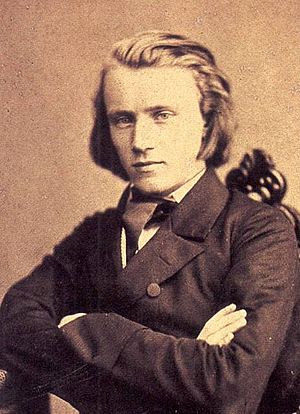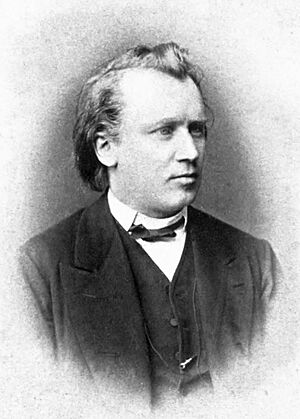Johannes Brahms facts for kids
Quick facts for kids
Johannes Brahms
|
|
|---|---|
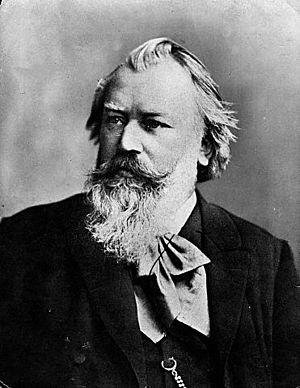
Picture by Carl Brasch, 1889
|
|
| Born | 7 May 1833 |
| Died | 3 April 1897 (aged 63) Vienna, Austria-Hungary
|
| Occupation |
|
| Parent(s) | Johann Jakob Brahms Johanna Henrika Christiane Nissen |
Johannes Brahms (born May 7, 1833 – died April 3, 1897) was a famous German composer, pianist, and conductor. He lived during the middle of the Romantic period in music. Brahms was born in Hamburg and spent most of his adult life in Vienna. Some people call him one of the "Three Bs" of music, along with Johann Sebastian Bach and Ludwig van Beethoven.
Brahms wrote music for many different groups. He composed for symphony orchestras, smaller groups called chamber ensembles, and solo instruments like the piano, organ, and violin. He also wrote music for singers and choirs. Brahms was a very skilled pianist himself. He often played his own new pieces for the first time. He worked with other top musicians of his time, like the pianist Clara Schumann and the violinist Joseph Joachim. They were all very good friends. Many of Brahms's musical works are still played often in concerts today.
People at the time, and even now, saw Brahms as both a traditional artist and someone who brought new ideas. His music was built on the strong structures and techniques of the Classical masters. But inside these structures, he put deep, romantic feelings. Some people thought his music was too serious. However, later composers like Arnold Schoenberg and Edward Elgar greatly admired his skill. The detailed way Brahms built his music inspired many composers who came after him.
Contents
Life Story
Growing Up (1833–1850)
Johannes Brahms's father, Johann Jakob Brahms, was a musician. He played string and wind instruments. In 1830, he married Johanna Henrika Christiane Nissen. Johannes was born in 1833. He had an older sister, Elisabeth, and a younger brother, Fritz. Fritz also became a pianist.
Johannes learned music from his father first. He also learned to play the violin and cello. From 1840, he studied piano with Otto Friedrich Willibald Cossel. Cossel noticed Brahms's talent for composing early on. When he was 10, Brahms played in a private concert. He performed pieces by Beethoven and Mozart. He also played a solo piece by Henri Herz. By 1845, he had already written a piano sonata. His parents wanted him to focus on performing, not composing.
From 1845 to 1848, Brahms studied with Eduard Marxsen. Marxsen knew Beethoven and Schubert. He loved the music of Mozart, Haydn, and J. S. Bach. Marxsen taught Brahms about these composers. This helped Brahms base his own music on their traditions. In 1847, Brahms played his first public solo piano concert in Hamburg. He played a piece by Sigismond Thalberg. His next concert in 1848 included a fugue by Bach. In April 1849, he played Beethoven's Waldstein sonata. Newspapers gave him good reviews.
During this time, Brahms wrote piano music, chamber music, and choir pieces for male voices. Some of his piano works were published in 1849 under a different name. Brahms later destroyed many of his early works. He wanted only his best pieces to be known.
Starting His Career (1850–1862)
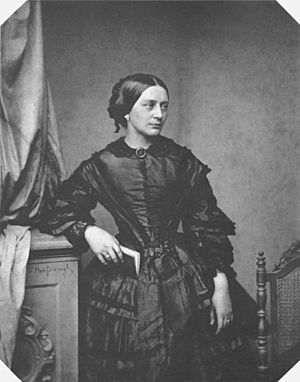
In 1850, Brahms met the Hungarian violinist Ede Reményi. They performed together for a few years. This introduced Brahms to "gypsy-style" music. This style later inspired his popular Hungarian Dances. Also in 1850, Brahms tried to contact Robert Schumann, another famous composer. He sent Schumann some of his music, but it was returned unopened.
In 1853, Brahms toured with Reményi. They visited the violinist Joseph Joachim in Hanover. Brahms had heard Joachim play before and was very impressed. Brahms played some of his piano pieces for Joachim. Joachim later said he was "completely overwhelmed" by Brahms's playing. This was the start of a lifelong friendship. Brahms also admired Joachim as a composer. They even practiced writing complex music forms together.
After meeting Joachim, Brahms and Reményi visited Weimar. There, Brahms met Franz Liszt. Liszt played Brahms's Op. 4 Scherzo just by looking at the music. Reményi claimed Brahms fell asleep during Liszt's performance of his own music. This and other disagreements led Brahms and Reményi to go their separate ways.
In October 1853, Brahms visited Düsseldorf. With a letter from Joachim, he met Robert Schumann and his wife Clara. Schumann was very impressed by the 20-year-old Brahms. He wrote an article called "New Paths" in a music magazine. In it, he praised Brahms as a great new talent. This praise made Brahms feel a lot of pressure. He worried he wouldn't be able to meet such high expectations. While in Düsseldorf, Brahms helped Schumann and his student Albert Dietrich write a violin sonata for Joachim.
Schumann's praise led to Brahms's first works being published under his own name. He went to Leipzig where his first piano sonatas and songs were printed. In Leipzig, he gave concerts and met other important musicians like Hector Berlioz.
In 1854, Robert Schumann became very ill and was sent to a mental hospital. Brahms stayed in Düsseldorf to help Clara Schumann. He managed their household and business matters. Brahms was able to visit Robert and pass messages to Clara. In June 1854, Brahms dedicated his Variations on a Theme of Schumann to Clara. Clara continued to support Brahms's career by playing his music in her concerts.
After 1854, Brahms didn't publish new works until 1860. During this time, he worked on his First Piano Concerto. He had started it as a piece for two pianos. He realized it needed a bigger sound. He also worked in Detmold during the winters from 1857 to 1860. There, he wrote his two Serenades. In Hamburg, he started a women's choir and wrote music for them. He also worked on his first two Piano Quartets during this period.
The end of the 1850s brought some challenges for Brahms. His First Piano Concerto was not well-received at its first performance in Hamburg in 1859. Brahms wrote that it was a "brilliant and decisive – failure." The audience reacted so badly at a second performance that Brahms almost left the stage. Because of this, his publisher refused his new music. Brahms then found other publishers, like Simrock, who became his main partner. Brahms also tried to join a public debate about German music in 1860. He and others criticized the "New German School" led by Liszt. They disliked how this group rejected traditional music forms. A draft of their criticism was leaked and made fun of Brahms. After this, Brahms never again spoke out publicly about music arguments.
Years of Growth (1862–1876)
Brahms hoped to become the conductor of the Hamburg Philharmonic. But in 1862, someone else got the job. In the autumn of 1862, Brahms visited Vienna for the first time. He stayed there for the winter. He met important musicians and critics who became his supporters.
In January 1863, Brahms met Richard Wagner for the first time. Brahms played his Handel Variations for Wagner. Their meeting was friendly. Wagner later made some critical comments about Brahms's music. However, Brahms remained interested in Wagner's music. He even helped with Wagner's concerts in Vienna.
Brahms decided to make Vienna his home. In 1863, he became the conductor of the Wiener Singakademie, a choir. He surprised audiences by playing music by old German masters like Heinrich Schütz and J. S. Bach. He also included music by Beethoven and Felix Mendelssohn. Brahms wrote music for the choir too. But he found the job took too much time away from composing. So, he left the choir in June 1864. From 1864 to 1876, he spent many summers in Lichtental, near Baden-Baden. Clara Schumann and her family also spent time there. Brahms wrote many major works in his Lichtental house, including A German Requiem.
In February 1865, Brahms's mother died. This inspired him to compose his large choral work, A German Requiem. He finished six movements by 1866. The full work was first performed in Bremen in 1868 and was a huge success. A seventh movement was added for a performance in Leipzig in 1869. The Requiem became famous throughout Germany and other countries. This marked Brahms's arrival as a world-renowned composer. He also had popular success with his first set of Hungarian Dances (1869) and his Liebeslieder Waltzes (1868/69).
After these successes, he finally finished works he had struggled with for years. These included his first two string quartets and his First Symphony. He had started the symphony as early as 1855, but it was not finished until 1876. In 1869, Brahms developed feelings for Clara Schumann's daughter, Julie. But he never told her. When Julie announced her engagement to someone else, Brahms wrote his Alto Rhapsody (Op. 53). Clara wrote in her diary that Brahms called it "his wedding song" and noted the deep sadness in the music.
From 1872 to 1875, Brahms directed concerts for the Vienna Gesellschaft der Musikfreunde. He made sure the orchestra had only professional musicians. He conducted music from Bach to his own large choral works. In 1873, his orchestral Variations on a Theme by Haydn premiered. This piece, originally for two pianos, became one of his most popular works.
Years of Fame (1876–1890)
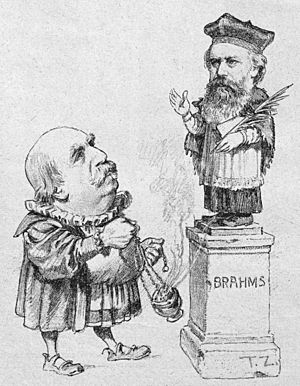
Brahms's First Symphony was finally finished in 1876. He had worked on it for about 15 years. Brahms was very careful about this symphony. He called it "long and difficult" and "not exactly charming." He also noted it was "long and in C Minor," which reminded people of Beethoven's famous Fifth Symphony.
In 1876, Cambridge University offered Brahms an honorary music degree. But he didn't want to travel to England. So, only Joachim went and received a degree. Brahms still sent his First Symphony's music to Joachim. Joachim conducted its first English performance in Cambridge in 1877.
Even though his First Symphony was well-received, Brahms kept changing the second movement before it was published. After this, he wrote many other successful orchestral pieces. These included the Second Symphony (1877), the Violin Concerto (1878), and the Academic Festival Overture and Tragic Overture (1880). The University of Breslau honored Brahms as "the leader in the art of serious music in Germany today."
Brahms was now seen as a major figure in music. He helped the less-known composer Antonín Dvořák by recommending him to his publisher. The two composers met in 1877. Dvořák even dedicated a string quartet to Brahms. Brahms also started receiving many awards.
Around this time, Brahms changed his appearance. In 1878, he surprised his friends by growing a beard. He wrote to a friend, "I am coming with a large beard! Prepare your wife for a most awful sight." A singer named George Henschel recalled seeing Brahms with his new beard. Brahms pretended to be someone else, and everyone laughed. This shows Brahms's love for jokes.
In 1882, Brahms finished his Second Piano Concerto. He dedicated it to his old teacher, Marxsen. Brahms was invited to perform it with the Meiningen Court Orchestra. This started his work with conductor Hans von Bülow. Von Bülow considered Brahms one of the greatest composers, after Bach and Beethoven. The next years saw the premieres of Brahms's Third Symphony (1883) and Fourth Symphony (1885). Richard Strauss, a young composer, was very impressed by Brahms's Third and Fourth Symphonies. Gustav Mahler also met Brahms in 1884 and admired his music.
In 1889, a representative from Thomas Edison visited Brahms in Vienna. He asked Brahms to make an experimental recording. Brahms played a short version of his first Hungarian Dance on the piano. The spoken introduction is clear, but the piano music is hard to hear because of noise.
In the same year, Brahms was made an honorary citizen of Hamburg, his hometown.
Final Years (1890–1897)
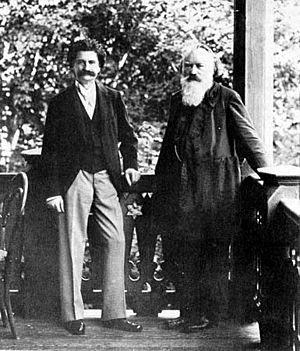
Brahms became good friends with Johann Strauss II, the famous waltz composer, in his later years. Brahms admired Strauss's music. He even encouraged Strauss to sign with his own publisher. Brahms once wrote the opening notes of Strauss's The Blue Danube waltz on a fan for Strauss's wife, adding "unfortunately not by Johannes Brahms."

After his Second String Quintet was successful in 1890, Brahms, at 57, thought about retiring from composing. He told a friend he had "achieved enough." But his admiration for Richard Mühlfeld, a clarinet player, made him want to compose again. This led him to write the Clarinet Trio (1891), Clarinet Quintet (1891), and two Clarinet Sonatas (1894). Brahms also wrote his last piano pieces and the Vier ernste Gesänge (Four Serious Songs) in 1896. These songs were inspired by the death of Clara Schumann. The last piece Brahms wrote was a setting of the organ chorale "O Welt ich muss dich lassen" ("O world I must leave thee"). Many of these later works were written in his summer house in Bad Ischl.
In the summer of 1896, Brahms was diagnosed with jaundice. Later that year, his doctor found he had liver cancer. His father had also died from this disease. Brahms's last public appearance was on March 7, 1897. He saw Hans Richter conduct his Fourth Symphony. The audience cheered after each part. He even made an effort to attend a new operetta by Johann Strauss just three weeks before he died. His health got worse, and he passed away on April 3, 1897, in Vienna, at age 63. Brahms is buried in the Vienna Central Cemetery in Vienna.
Brahms's Music
Musical Style and Inspirations
Brahms kept a classical sense of form and order in his music. This was different from the grand, rich music of many other composers at the time. Because of this, many people saw him as a defender of traditional forms and "pure music." This was in contrast to the "New German" composers who preferred music that told a story or described something.
Brahms greatly admired Beethoven. In his home, he had a statue of Beethoven looking over his composing spot. Some parts of Brahms's music remind people of Beethoven's style. For example, Brahms's First Symphony is very similar to Beethoven's Fifth Symphony. Both are in C minor and end with a feeling of triumph in C major. The main tune of Brahms's First Symphony's ending also sounds like the main tune of Beethoven's Ninth Symphony's ending. When someone pointed this out, Brahms joked that "any dunce could see that."
Brahms was a master of counterpoint. This means he was very skilled at weaving together different melodies at the same time. One writer said that for Brahms, "the most complicated forms of counterpoint were a natural means of expressing his emotions." He could turn complex musical techniques into beautiful, emotional pieces.
He was also very clever with rhythm and meter. Some believe his experience with Hungarian folk music as a teenager influenced his love for unusual rhythms. His Hungarian Dances are among his most loved pieces. One expert said that "only one composer rivals him in the advanced nature of his rhythmic thinking, and that is Stravinsky."
His skills in counterpoint and rhythm are clear in A German Requiem. This work was partly inspired by his mother's death in 1865. But it also uses music from an earlier symphony he had started.
Brahms loved classical composers like Mozart and Haydn. He especially admired Mozart, even saying he was the greatest composer in his final years. Brahms collected old copies of Mozart and Haydn's music. He also studied music from even older composers, like Johann Sebastian Bach. He looked to this older music to learn about counterpoint. For example, the ending of his Fourth Symphony uses a special form called a passacaglia, inspired by Bach.
Early Romantic composers also influenced Brahms. Schumann, in particular, encouraged him when he was young. Brahms became very interested in Franz Schubert's music during his time in Vienna. Schubert's influence can be heard in Brahms's piano quartets and piano quintet.
Brahms considered stopping composing when new musical ideas seemed to break all the old rules of harmony. Even though Richard Wagner later criticized Brahms, Brahms himself admired Wagner's music. He just didn't agree with all of Wagner's ideas about opera.
Brahms also wrote music for 144 German folk songs. Many of his songs reflect folk themes or show scenes of country life.
Major Works
Brahms wrote many important pieces for orchestra. These include four symphonies, two piano concertos, a Violin Concerto, and a Double Concerto for violin and cello. He also wrote the Tragic Overture and the Academic Festival Overture.
His large choral work, A German Requiem, is not a traditional church service for the dead. Instead, Brahms chose texts from the Bible that he felt were comforting. He worked on this piece at different times in his life. Most of it was written after his mother died in 1865.
Brahms also wrote many pieces using a "variation" form. This means he took a musical theme and changed it in many different ways. Examples include his Variations and Fugue on a Theme by Handel and Paganini Variations for solo piano. The last movement of his Fourth Symphony is also a set of variations.
His chamber music includes three string quartets, two string quintets, two string sextets, and a clarinet quintet. He also wrote trios (for three instruments) and quartets (for four instruments) involving piano, horn, and clarinet. He composed several sonatas for instruments with piano, like for violin, cello, and clarinet. His solo piano works range from early sonatas to later character pieces. Brahms was also a very important composer of Lieder (German songs), writing over 200 of them. His chorale preludes for organ, written shortly before his death, are important organ pieces. The very last notes he wrote were for one of these organ pieces.
Brahms was a huge perfectionist. He destroyed many of his early works. He once said he destroyed 20 string quartets before he finally published his official First String Quartet in 1873. He worked on his First Symphony for almost 15 years. Even after its first performances, he changed one of the movements before it was published.
One reason for his perfectionism was Robert Schumann's early praise. Brahms was determined to live up to those high expectations.
Brahms strongly preferred writing music that didn't tell a specific story or describe a scene. He never wrote an opera or a symphonic poem.
Influence on Other Composers
Brahms's music looked both to the past and to the future. His works often explored new ideas in harmony and rhythm. Because of this, he influenced composers with both traditional and modern styles.
During his lifetime, his music influenced composers close to him, like Heinrich von Herzogenberg and Julius Röntgen. Antonín Dvořák, who Brahms helped a lot, greatly admired his music. Dvořák's Seventh Symphony and Piano Trio show Brahms's influence. Composers like Max Reger and Edward Elgar also learned much from Brahms. Elgar once said, "I look at the Third Symphony of Brahms, and I feel like a pygmy."
Later in his life, Brahms encouraged young composers like Ernst von Dohnányi and Alexander von Zemlinsky. Their early works show how much they learned from Brahms. Zemlinsky was also the teacher of Arnold Schoenberg. Brahms was impressed by some of Schoenberg's early string quartet music. In 1933, Schoenberg wrote an essay called "Brahms the Progressive." He pointed out how Brahms used musical ideas in new ways and had interesting rhythms. This helped people see Brahms's music in a new light in the 20th century. Schoenberg even arranged one of Brahms's piano quartets for orchestra.
Schoenberg's student, Anton Webern, also said that Brahms's music hinted at new developments in music. Webern's own first orchestral piece was a tribute to Brahms's variation techniques.
Brahms was honored in the German hall of fame, the Walhalla memorial. In 2000, a bust of him was placed there as one of Germany's most distinguished people.
Pianos Brahms Used
Brahms mainly played on German and Viennese pianos. In his younger years, he used a piano from the Hamburg company Baumgarten & Heins. Later, he really liked pianos made by Johann Baptist Streicher. In 1873, he got a Streicher piano and kept it until he died. He wrote to Clara Schumann, "There [on my Streicher] I always know exactly what I write and why I write one way or another." He also owned a Conrad Graf piano, which was a wedding gift to the Schumanns. Clara later gave it to Brahms.
For his public concerts in the 1880s, Brahms sometimes used a Bösendorfer piano. He also played on a Steinweg Nachfolgern and a Blüthner piano in some concerts. Brahms used a Bechstein piano for several performances as well.
Brahms's Beliefs
Brahms was baptized into the Lutheran church as a baby. He was confirmed at age fifteen. However, he has been described as someone who questioned religious beliefs and focused on human values. The very religious composer Antonín Dvořák once wrote in a letter: "Such a man, such a fine soul – and he believes in nothing! He believes in nothing!"
When asked to add more clearly religious words to his German Requiem, Brahms reportedly said he would rather use the word "Human" instead of "German." He also said he would gladly leave out certain Bible verses. He explained that he chose the texts as a musician, because they fit the music he wanted to write.
See also
 In Spanish: Johannes Brahms para niños
In Spanish: Johannes Brahms para niños


